The nuclear obscurer of Active Galactic Nuclei
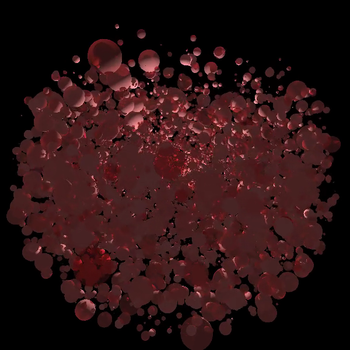
What do we know about the nuclear obscurer of Active Galactic Nuclei (AGN), also colloquially called the torus?
-
Most AGN are obscured
Deep X-ray surveys reveal that most growth of super-massive black holes is hidden behind thick layers of gas and dust. Correcting for selection effects, we know that 77% of AGN are obscured, (average over luminosity and cosmic time). This implies very high covering fractions is common, as illustrated below:
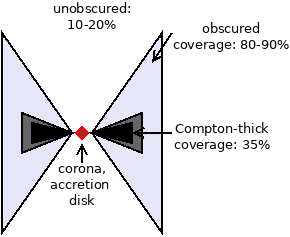
-
The galaxy obscures a little too
By sitting in the centres of galaxies, AGN can be obscured by large-scale gas and dust at kilo-parsec scales. We estimated this effect by studying obscuration of other X-ray sources, and carefully translating it to the AGN host galaxy population.
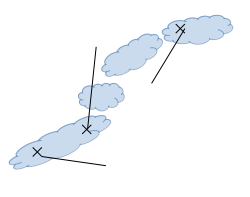
Ultimately, the large-scale galaxy gas can account for up to 40% of the obscuration.
-
Multiple obscurers
Even when we see an AGN unobscured or mildly obscured, the X-ray spectra show Compton scattering and X-ray fluorescence that must originate from very dense material covering much of the X-ray source. Seen in Chandra for typical AGN and NuSTAR for nearby sources
-
Obscuration is variable
Long observations of distant and nearby AGN have shown drastic changes in the line-of-sight obscuration, revealing previously obscured AGN and hiding previously unobscured AGN. These are interpreted as transits of gas clumps in front of the X-ray emitting plasma (corona).

I am actively searching for such events with the new X-ray surveyer eROSITA.
- 77% obscured
- 40% obscured by host
- 38% Compton-thick
- 1/1000 change obscuration per day
What is then a reasonable working model?
UXCLUMPY is a clumpy obscurer model, which reproduces- The obscured fraction (Compton-thin and Compton-thick)
- The frequency of occultations
- The X-ray spectra of nearby AGN
- The infrared spectra of AGN
Fly-through of the model (360° VR):
What is the physical origin of the nuclear obscurer?
Open questions:- What keeps this structure from collapsing into a disk?
- How are the clumps or sub-structures created? What mechanism governs their life cycle?
- Is the torus produced by gas that could not reach the black hole, or is it produced through outflows from the accretion disk? Are supernovas in nuclear star clusters important?
- How is the larger host galaxy connected to and interacting with the torus? Does it change with the host morphology (mergers, bulges)?
Below are some models explaining the origin of the obscurer.
-
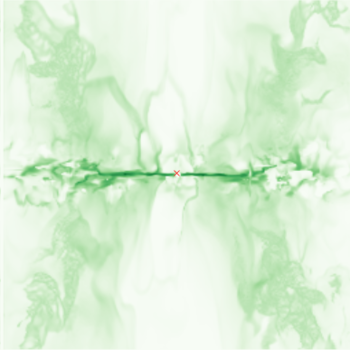
Radiative fountain
In these model, radiation pressure blows out gas, but instead of escaping, it falls back and creates a fountain-like structure. The outflow or wind is produced primarily by supernovas and the AGN. Download the X-ray spectral model. Keichi Wada and Marc Schartmann have worked extensively on these types of models.
-
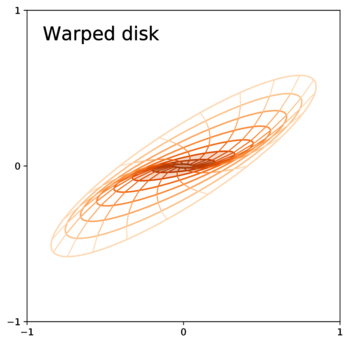
Warped and tilted disks
Warps are known from water maser observations in some nearby AGN, such as Circinus. These are produced by dense co-planar, co-moving gas, such as in disks seen edge-on. Clumps expelled in the polar direction are also observed, and may dominate the infrared emission. Download the X-ray spectral model.
X-ray reflection spectroscopy
To test such physically motivated geometries, and ad-hoc geometries against nature, we can use X-ray reflection spectroscopy: X-rays emitted close to the black hole interact with the electrons in cold, dense gas. Compton scattering changes their energies and redirects the photons, allowing them to by-pass a line-of-sight obscurer. As illustrated here:

The geometry influences the emerging spectrum strongly. An important concept is the mean free path after the first photon interaction. Spectral differences are most noticably at 10-40keV (the Compton hump) and 3-6keV (low-energy Compton scattering tail). The X-ray spectrum thus contains imprints of the geometry, as shown here in the comparison between a clumpy torus and a smooth torus:
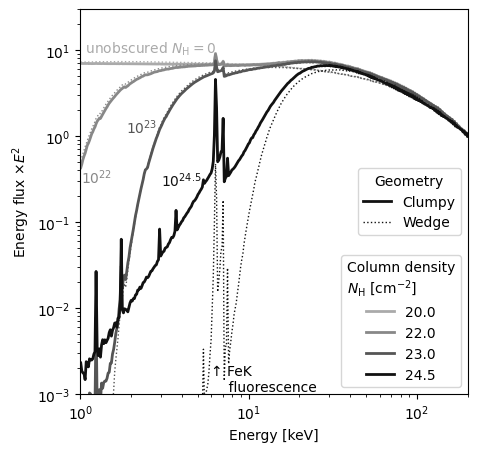
To infer the geometry, Monte Carlo simulations are necessary to predict X-ray spectra. The XARS simulator can efficiently irradiate:
- Analytic geometries such as spheres
- Assemblies of 100,000s of spheres
- Hydro-radiative simulations